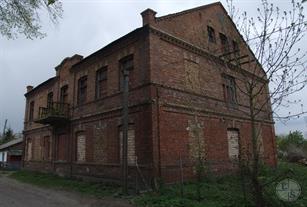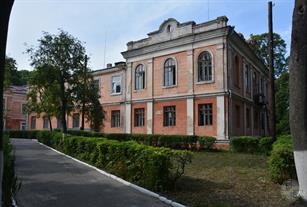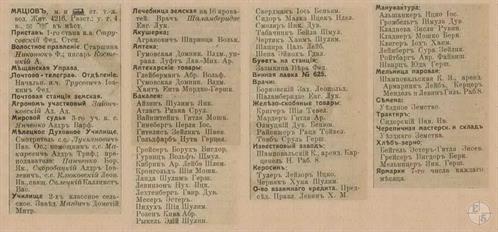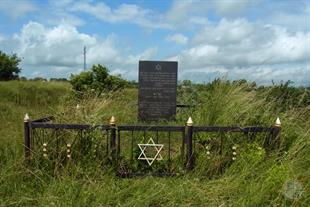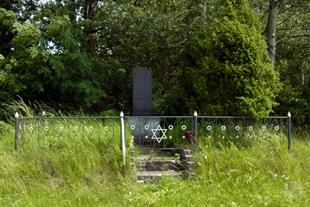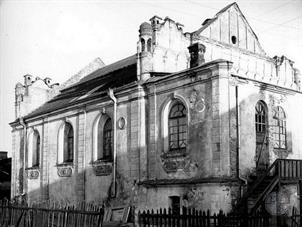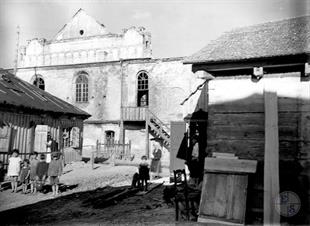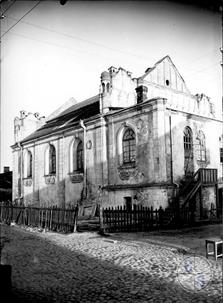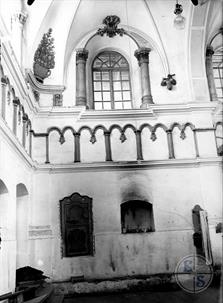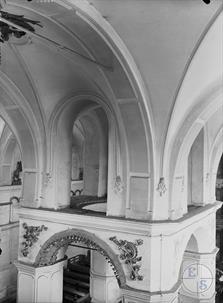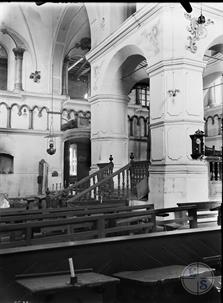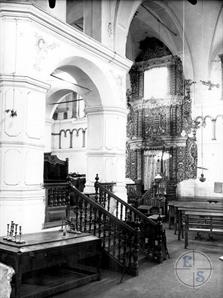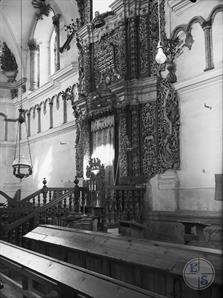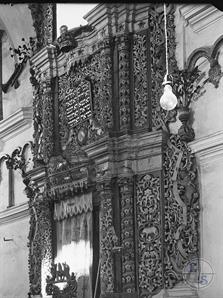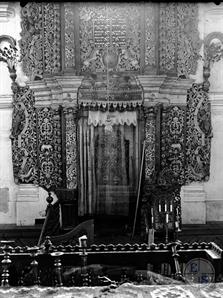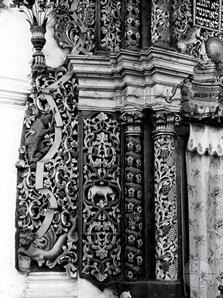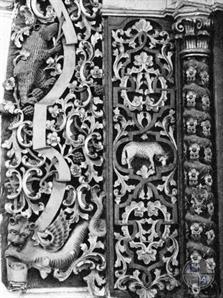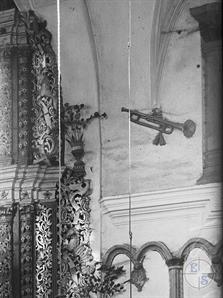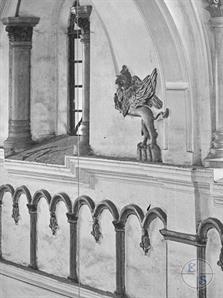Lukiv (Matseiv)
Kovel district, Volyn region
Sources:
- Virtual Shtetl. Lukiv;
- Yad Vashem. Maciejow;
- The All South-Western Territory: reference and address book of the Kyiv, Podolsk and Volyn provinces. Printing house L.M. Fish and P.E. Wolfson, 1913;
- Encyclopedia of Jewish Life before and during the Holocaust, eds. S. Spector, G. Wigoder, New York 2001, vol. II, p. 780.
Photo:
- Nataliya Shestakova, Wikipedia. Mionchynskykh palace, Lukiv
- Viacheslav Galievskyi, Wikipedia. Mass grave of Jews killed by nazis in Lukiv
- Sergey Kravtsov, Center for Jewish Art. Jewish school in Lukiv
- Szymon Zajczyk (1930), Instytut Sztuki Polskiej Akademii Nauk
- Virtual Shtetl. Lukiv;
- Yad Vashem. Maciejow;
- The All South-Western Territory: reference and address book of the Kyiv, Podolsk and Volyn provinces. Printing house L.M. Fish and P.E. Wolfson, 1913;
- Encyclopedia of Jewish Life before and during the Holocaust, eds. S. Spector, G. Wigoder, New York 2001, vol. II, p. 780.
Photo:
- Nataliya Shestakova, Wikipedia. Mionchynskykh palace, Lukiv
- Viacheslav Galievskyi, Wikipedia. Mass grave of Jews killed by nazis in Lukiv
- Sergey Kravtsov, Center for Jewish Art. Jewish school in Lukiv
- Szymon Zajczyk (1930), Instytut Sztuki Polskiej Akademii Nauk
Lukiv (untill 1946 - Matseiv, Maciejow). In 1537, the settlement was first mentioned in written sources as the village of Lukovo Maceev. From 1795 - as part of the Russian Empire. In the 19th - beginning of the 20th century - the township of Matseiv of Kovel district of the Volyn province.
In 1897, 2,337 Jews lived in Matseiv (60%);
in 1921 - 2,206 Jews (74,1%);
in 1941 - approx. 2,600 Jews, including refugees from other settlements.
In 1897, 2,337 Jews lived in Matseiv (60%);
in 1921 - 2,206 Jews (74,1%);
in 1941 - approx. 2,600 Jews, including refugees from other settlements.
The Jewish community in Matseiv was mentioned for the first time in 1563. In 1897, its size reached its peak – 2,337 Jews lived in the town with a total population of 3,897 (60%). Most community members were followers of the Trisk Hasidim.
Crafts and trade were the main source of income of the local Jewish residents. They often struggled with making ends meet.
Between the two world wars the Bund and various Zionist parties, especially the Hehalutz pioneer youth movement, were active in the town. Many Jewish children attended the Tarbut Zionist Hebrew-language kindergarten and the Tarbut sponsored elementary school.
In 1913, Jews owned all 3 pharmacy warehouses, all 42 shops (including 24 grocery, 8 manufactory). Jews also rented only mill, only lime factory, and managed only pharmacy.
Jewish credit company acted; the chairman was H. Levin.
In September 1939, with the entry of the Red Army into the town following the Ribbentrop-Molotov Pact, Matseiv became part of Soviet Ukraine. Private enterprises were closed down and the Tarbut institutions were replaced with Soviet ones. It is estimated that in 1941 about 2,600 Jews were living in the town.
Crafts and trade were the main source of income of the local Jewish residents. They often struggled with making ends meet.
Between the two world wars the Bund and various Zionist parties, especially the Hehalutz pioneer youth movement, were active in the town. Many Jewish children attended the Tarbut Zionist Hebrew-language kindergarten and the Tarbut sponsored elementary school.
In 1913, Jews owned all 3 pharmacy warehouses, all 42 shops (including 24 grocery, 8 manufactory). Jews also rented only mill, only lime factory, and managed only pharmacy.
Jewish credit company acted; the chairman was H. Levin.
In September 1939, with the entry of the Red Army into the town following the Ribbentrop-Molotov Pact, Matseiv became part of Soviet Ukraine. Private enterprises were closed down and the Tarbut institutions were replaced with Soviet ones. It is estimated that in 1941 about 2,600 Jews were living in the town.
The Germans occupied Matseiv on June 24, 1941. Within a few days a Jewish council (Judenrat) was established by the Germans. The council told the male Jews where and when to report for forced labor, initially for clearing the roads of small mines left behind by the Soviets as they retreated. Shortly afterwards, the German authorities ordered the Jews to wear white armbands with the Star of David (which were replaced later by yellow patches) on the front and back of their clothes. The Jewish houses had to be marked as well.
The Jews were also ordered to surrender all valuables (gold, furs, etc.) via the Judenrat. In addition, the Germans demanded large monetary payments. On one occasion they burned the Torah scrolls from the synagogue and abused and humiliated old Jewish men. On another occasion the Germans beat and then murdered the rabbi of the town, apparently when their demands for money could no longer be met.
During this first period of German occupation the Jewish population was placed under evening curfew. It was also prohibited from using any means of transportation. Later, Jews had to perform different kinds of forced labor - men swept the streets, worked at the sawmill, and loaded freight cars, while women cleaned German headquarters and did the laundry for the German authorities.
On July 18, 1941, several hundred Jewish men were shot to death behind the local Catholic Church (that served as the German headquarters) by members of the Security Police and an SD murder squad, assisted by the Gendarmerie (German rural order police). A month later, according to one testimony, 300 Jewish young women were shot to death in the same place.
Apparently at the end of summer 1941, an open ghetto was set up, where the remaining Jews from Matseiv and surrounding villages were concentrated. According to one testimony an orphanage was opened in the ghetto for children whose parents had been killed.
In late August or early September 1942 the ghetto of Matseiv was liquidated. The surviving Jews, mainly women, children, and elderly people, were shot to death in the lime quarry on the edge of town. In 1942 and/or 1943 several hundred Jews who had managed to flee to the woods during and after the murder operations were caught and murdered.
The Jews were also ordered to surrender all valuables (gold, furs, etc.) via the Judenrat. In addition, the Germans demanded large monetary payments. On one occasion they burned the Torah scrolls from the synagogue and abused and humiliated old Jewish men. On another occasion the Germans beat and then murdered the rabbi of the town, apparently when their demands for money could no longer be met.
During this first period of German occupation the Jewish population was placed under evening curfew. It was also prohibited from using any means of transportation. Later, Jews had to perform different kinds of forced labor - men swept the streets, worked at the sawmill, and loaded freight cars, while women cleaned German headquarters and did the laundry for the German authorities.
On July 18, 1941, several hundred Jewish men were shot to death behind the local Catholic Church (that served as the German headquarters) by members of the Security Police and an SD murder squad, assisted by the Gendarmerie (German rural order police). A month later, according to one testimony, 300 Jewish young women were shot to death in the same place.
Apparently at the end of summer 1941, an open ghetto was set up, where the remaining Jews from Matseiv and surrounding villages were concentrated. According to one testimony an orphanage was opened in the ghetto for children whose parents had been killed.
In late August or early September 1942 the ghetto of Matseiv was liquidated. The surviving Jews, mainly women, children, and elderly people, were shot to death in the lime quarry on the edge of town. In 1942 and/or 1943 several hundred Jews who had managed to flee to the woods during and after the murder operations were caught and murdered.
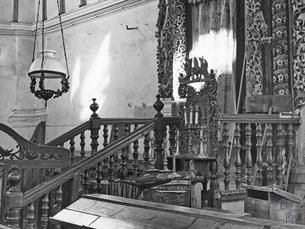 |
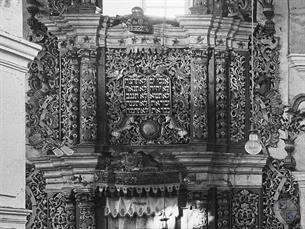 |
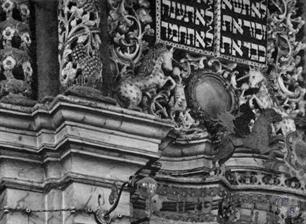 |
| Lifting to Aron Kodesh and a candle stand, 1939 | The upper part of Aron Kodesh, 1930. In the center above the crown, below - birds, arms with tablets, a pair of unicorns | Spotted unicorns, 1930 |
Above the entrance to the synagogue there was a unique sculptural group - the illustration of the prophecy of Ieshayahu "The cow and the bear will graze together" (Ieshayahu 11: 7). But the bear, pay attention, just in case on the chain - a hint that the messianic times have not yet come.
It was also indicated that "the work completed by power of Lord, in year 541 by small count (1781), Jezhezkel, the son of Moshe from the Sokal community, may we be awarded in the house of Ariel." It is interesting that coincided the year of construction and hematria of the word "Israel" - 541, that is, literally says: "... in the year of Israel ...".
Another interest moment is the mention of the "House of Ariel", the synonym for the Jerusalem Temple. In Tanah, this phrase is not found; it was introduced into everyday life, probably Amsterdam Rabbi Shmuel Ben Arye Leib Lovenstam, who published a work with the same name in Amsterdam ("Binyan Ariel"). The most interesting thing here is that before Amsterdam Shmuel Lovenstam was a rabbi in the village of Lokachi in Volynia, about 60 km from Matseiv (Lukiv).
Below this inscription, above the entrance - a standard phrase for many synagogues "This is the gates of the Almighty, the righteous will enter them" (Tehilim 118: 20)
It was also indicated that "the work completed by power of Lord, in year 541 by small count (1781), Jezhezkel, the son of Moshe from the Sokal community, may we be awarded in the house of Ariel." It is interesting that coincided the year of construction and hematria of the word "Israel" - 541, that is, literally says: "... in the year of Israel ...".
Another interest moment is the mention of the "House of Ariel", the synonym for the Jerusalem Temple. In Tanah, this phrase is not found; it was introduced into everyday life, probably Amsterdam Rabbi Shmuel Ben Arye Leib Lovenstam, who published a work with the same name in Amsterdam ("Binyan Ariel"). The most interesting thing here is that before Amsterdam Shmuel Lovenstam was a rabbi in the village of Lokachi in Volynia, about 60 km from Matseiv (Lukiv).
Below this inscription, above the entrance - a standard phrase for many synagogues "This is the gates of the Almighty, the righteous will enter them" (Tehilim 118: 20)
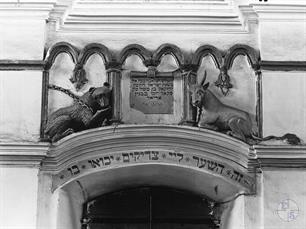 |
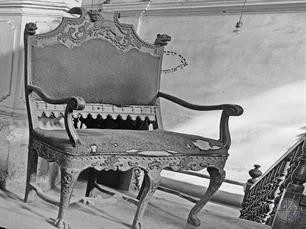 |
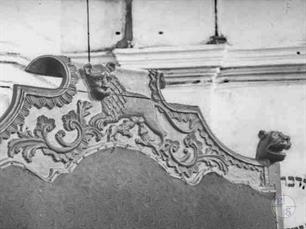 |
| Sculptural group, decor and inscriptions above the entrance to the synagogue, 1930 | The chair of the Prophet Eliyahu. Lioness and 2 lion cubs on the back, legs in the form of lion paws |
The interior of the synagogue and its main elements - Bimah and Aron Kodesh, were richly decorated with carvings and sculptural images. This decor can be seen in the photographs that have come down to us, first of all, thanks to the works of the Polish-Jewish photographer Shimon Zaychik, who photographed the synagogue in 1930.
Especially luxurious in the synagogue was Aron Kodesh. The arks with scrolls of the Torah have always been decorated as richly as possible, but the Matseiv ark is simply incredible..
The synagogue was erected in 1781. At Soviet time, it was used as a hostel of a professional school. After the Second World War, the building was dismantled.

- Home
- Shtetls
- Vinnytsia region
- Volyn region
- Dnipro region
- Donetsk region
- Zhytomyr region
- Zakarpattia region
- Zaporizhzhia region
- Ivano-Frankivsk region
- Kyiv region
- Kropyvnytskyi region
- Luhansk region
- Lviv region
- Mykolayiv region
- Odessa region
- Poltava region
- Rivne region
- Sumy region
- Ternopil region
- Kharkiv region
- Kherson region
- Khmelnytskyi region
- Chernihiv region
- Chernivtsi region
- Cherkasy region
- Crimea
- Synagogues
- Cemeteries
- Objects & guides
- Old photos
- History
- Contact
Jewish towns of Ukraine
My shtetl
My shtetl
Donate
Jewish towns of Ukraine
